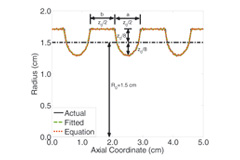Accueil
Subtracted dispersion relation estimate of two-photon exchange (Vol. 46 No. 3)

Elastic electron-proton scatterings (with one-photon exchange) have always provided fundamental information on general properties of the proton. Recently, two experimental approaches, with and without polarized protons, gave strikingly different results for the electric over magnetic proton form factor ratio. Similarly, a mysterious discrepancy (“the proton radius puzzle”) has been observed in the measurement of the proton charge radius in different experiments, one of which is electron-proton scattering. Two-photon exchange (TPE) contributions have been proposed as a plausible solution to resolve the puzzles, but their estimates have strong model dependences. A quantitative understanding of TPE effects, based on general principles and avoiding model dependences, is necessary. A subtracted dispersion relation formalism for the TPE has been developed and tested. Its relative effect δ2γ on the elastic cross section is in the 1-2 % range for a low value of the momentum transfer Q2 as function of the kinematic parameter ε, ranging between ε = 0 (backward scattering) and ε = 1 (forward scattering). Summarizing, the paper studies in a theoretical framework which minimizes the model dependence, the TPE contributions to electron-proton scattering, a precision experiment crucial for measuring the most fundamental proton properties.
O. Tomalak and M. Vanderhaeghen, Subtracted dispersion relation formalism for the two-photon exchange correction to elastic electron-proton scattering: Comparison with data”, Eur. Phys. J. A 51, 24 (2015)
[Abstract]
The new frontier in plasma medicine (Vol. 46 No. 3)

Data on the transport of electrical charges in water vapour provide the key ingredients to new plasma models applicable to medicine.
Applications of plasmas in medicine are a new frontier in therapeutic treatment. For example, they can help in stimulating tissue regeneration in the contexts of wound healing and dermatology. Before these and further applications can be developed, it is essential to understand the processes at work in plasmas—a unique kind of gas-like state of matter containing charged particles. Now a study published by the authors provides previously unavailable data on oxygen ion transport and the likelihood of such ions interacting with water molecules. These could contribute to new models of plasmas in liquids which account for how discharges are created in water vapour.
V. Stojanović, Z. Raspopović, D. Marić and Z. Lj. Petrović, Cross sections and transport of O- in H2O vapour at low pressures, Eur. Phys. J. D 69, 63 (2015)
[Abstract]
Novel high-power microwave generator (Vol. 46 No. 3)

A new study explores the viability of a novel structure to be used as a component of a high-power microwave source, designed to transfer energy to targets via ultra-high-frequency radio waves.
High-power microwaves are frequently used in civil and military applications. In a new study the authors demonstrate that their proposed novel method, which is capable of producing such microwaves, offers a viable alternative to traditional approaches.
To generate such high-power microwaves, researchers rely on devices referred to as backward wave oscillators, which are designed to transform the energy of an intense electron beam propagating in a slow electro-dynamic structure—SWS—into electromagnetic radiation at microwave frequencies.
Metallic cylinders with a sinusoidally shaped, periodically corrugated inner wall are being extensively used as SWS. But they are difficult to manufacture. Now, the authors propose an alternative shape of the SWS, in the form of a novel semi-circular structure and prove it is a viable alternative for generating high-power microwaves.
Md. Ghulam Saber, R.Hasan Sagor and Md. Ruhul Amin, Numerical study of the dispersion characteristics of a semi-circularly corrugated slow wave structure, Eur. Phys. J. D 69, 38 (2015)
[Abstract]
Disparity in electron and phonon mean-free-paths (Vol. 46 No. 3)

There has been intensified interest in high performance thermoelectric materials in the last two decades, largely owing to the nanostructuring approaches that significantly reduce heat leakage by phonons. A condition for the nanostructuring approaches to be effective is the phonon mean free path (MFP) much longer than that of electrons so that phonons are more frequently scattered at the interfaces. While there has been a recent significant progress in the first-principles understanding of phonon MFP spectral distributions, the spectral distribution of electron MFPs remains unknown.
In this work the authors compute from first-principles the energy dependent electron scattering and MFPs in silicon. They show that electrons and phonons have very different MFP distributions with phonon MFPs significantly longer than those of electrons. The authors show with a model that silicon 20 nm grains can yield a more than five times enhancement in the thermoelectric figure of merit, since the grain boundaries scatter phonons more significantly than electrons due to their different MFP distributions. This work provides new fundamental insights by quantitatively revealing the disparity in electron and phonon MFP distributions from first principles.
B. Qiu, Z. Tian, A. Vallabhaneni, B. Liao, J. M. Mendoza, O. D. Restrepo, X. Ruan and G. Chen, First-principles simulation of electron mean-free-path spectra and thermoelectric properties in silicon, EPL, 109, 57006 (2015)
[Abstract]







